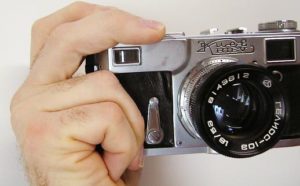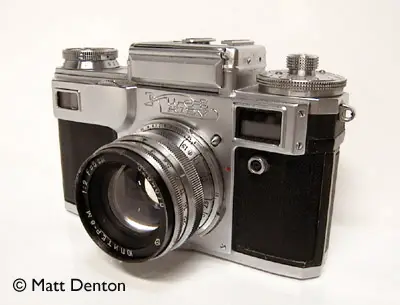- Produced 1947-1987 (1962) Arsenal, Kiev, Ukraine
- Film type 135 (35mm)
- Picture size 24 x 36mm
- Weight 27.2oz (771.1g) with Jupiter-8 (“white”)
- Lens Jupiter-8 (Arsenal copy of Zeiss Sonnar) 50mm 1:2.0
- Focal range .9m to infinity
- Filter size 40.5mm threaded, 42mm slip-on
- Shutter metal curtain (whisper quiet!)
- Shutter speeds B, 1/2-1/1250 (yes, that’s right)
- Viewfinder coupled rangefinder
- Exposure meter uncoupled selenium cell
- Self-timer
- Accessory shoe, PC sync connection
Overview
This is it, the one that started my buying binge, the collector’s item that infected me with the Russian rangefinder bug and the Classic Camera bug. The Kiev 4 had been described in an ebay auction by a camera dealer — the irony was lost on me at the time — as a ‘Poor Man’s Leica’ (aren’t they all!) and I thought, hm, I’ll never be able to afford an actual Leica, but $40 isn’t bad for a nice old classic, and then the research began, and that led to other research, and when I finally had the thing in my hot little hands and smelled the old leather and hefted the alien beast to my eye…
You know what happened next.
I won’t bore you with the story of how at the end of WWII the Russians took the Carl Zeiss camera dies and machinery from Jena back to Kiev and converted the Arsenal there into a camera factory, churning out Zeiss Contax clones…it’s a good one though, and you can read about it by following some of the links below.
The Kiev 4 is a heavy metal camera with a surprisingly quiet shutter. Almost as quiet as the Copal on my Yashica Electro, believe it or not. The Jupiter-8 is sharp and contrasty like a good Zeiss Sonnar clone should be, and the LTM (Leica thread mount) version is good enough that they are often used on Leica bodies. The rangefinder on the Contax is legendary, note the extreme distance between the windows, supposedly helping make it one of the most accurate rangefinders ever, in addition to being one of the first cameras with a combined rangefinder/viewfinder window. (Note that this wide window spacing also makes it tricky to hold properly – there is a ‘Contax hold’ you use with these so you don’t cover that window with your fingers, see below.) While this is not an actual Contax it’s as close as I ever intend to get, and yes the rangefinder is spot on after 40 years. I have to say I love this camera – the way it smells, the heft of it, the solidity of it, the smoothness of focusing and of the shutter operation. The exposure meter appears to be wildly inaccurate but no matter. Selenium cells can certainly be unreliable after several decades if they work at all. I did do some research about how to read the meter scale, and frankly it’s not really worth the mental gymnastics. You’re better off using sunny-16 or a real light meter. Like a lovely Leningrad or Sverdlovsk for instance!
Repairs
Hardly worth mentioning but I did have to glue down a corner of the leatherette with some Pliobond. The advantage of using Pliobond is that I will be able to peel the leather off again later if I ever need to. Also I gave the camera a good thorough surface cleaning. I’ve been reluctant to take this one apart as it’s *such* a classic, and it’s working well.
Extra Credit
I do like the case, it’s stylish and smells like old camera, but it’s a bit heavy and awkward and the top is riveted to the bottom so you can never shed any of the weight. UNTIL: for about $5US at your local fabric / craft store in the notions section (where the zippers and stuff are) you can get a heavy duty snap kit that will allow you to actually replace that rivet with a snap. I got the rivet out with some needlenose pliers and elbow grease, then put the snap on the upper portion of the case, no modification necessary since there was already a hole from the rivet. I then carefully lifted up the red leather lining of the bottom half of the case and slipped the post portion of the other snap in hole left by the rivet, replaced the lining, and punched it with a block of wood behind it. The snap pieces each are made of two parts that go together with a hammer and a punch, the whole thing took about 15 minutes and now I have an even better user!

Tips & Tricks
Rule one for rangefinders is of course remove the lens cap! (Yes I’ve forgotten, with this very camera. It’s embarassing to have your subject point out your ignorance of your own equipment!) Now, I’m a big proponent of using not only lens caps but UV filters for protection, especially when you have an old valuable lens like the Jupiter-8. Luckily 40.5mm is a current if not common size; it’s used on movie cameras. Good new UV filters and lens caps in all sizes can be got cheaply online. Also with the Kiev I love having the focus wheel on top and I find that though I don’t always use it first, it’s nice to have it there for fine-tuning focus (luckily the rangefinder is pretty accurate on this one). Try not to lose the takeup spool! If you do, though, see link below on how to fabricate a replacement from a used 35mm cassette (works on any Zeiss type camera, a Contaflex for instance).
Speaking of that focus wheel, there’s a thing about Kiev / Contax – the rangefinder windows are so far apart you actually have to hold the camera differently to avoid putting your finger on the window. It’s called the ‘Contax Hold’ and it goes like this:

Basically you focus with your middle finger and shoot with your index, while keeping your other two fingertips away from the window. Takes a little practice but you’ll get used to it in no time.
Here’s something it took me a while to notice – the tripod mount is not the standard western 1/4″ mount, but a larger 3/8″ one like the head mount on a Bogen. Adapters are available but may take some looking.
Another little funny thing, you manually set the film counter to 24 or 36 when you are ready to start shooting, then it counts backwards to zero to let you know how many pictures you have left. This is true not only of several cameras of the era (Argus C3, Kodak 35) but of many FSU (Former Soviet Union) cameras in general, I find.
There’s a popular saying about playing Russian Roulette when you’re buying an FSU-made camera, the quality varies wildly depending on how much Vodka the workers had imbibed that day at the factory. I think that’s true to some extent – there was once a quota system that emphasized quantity over quality – but I believe the models from the 60s tend to be fine examples of solid workmanship, I think it’s the newer (70s on) where the quality can be hit or miss. The examples I own are extremely well made.
Related Links
- A great Kiev 4 page with all you wanted to know and more, including a manual in english
- Sovietcams.com, a nice site with specs on various Russian cameras including the Kiev 4
- The difference between the Contax III and the Kiev 4
- And even though it’s not really a Contax, this nice Zeiss Contax info site is great
- The one at Cameraquest is even better
- If you lose the takeup spool or get one without, Mike Elek has an easy way to make a replacement
